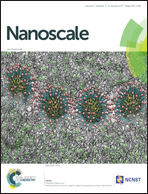Stepwise reversible nanomechanical buckling in a viral capsid†
Abstract
Viruses are nanoscale infectious agents constructed of a proteinaceous capsid that protects the packaged genomic material. Nanoindentation experiments using atomic force microscopy have, in recent years, provided unprecedented insight into the elastic properties, structural stability and maturation-dependent mechanical changes in viruses. However, the dynamics of capsid behavior are still unresolved. Here we used high-resolution nanoindentation experiments on mature, DNA-filled T7 bacteriophage particles. The elastic regime of the nanoindentation force trace contained discrete, stepwise transitions that cause buckling of the T7 capsid with magnitudes that are integer multiples of ∼0.6 nm. Remarkably, the transitions are reversible and contribute to the rapid consolidation of the capsid structure against a force during cantilever retraction. The stepwise transitions were present even following the removal of the genomic DNA by heat treatment, indicating that they are related to the structure and dynamics of the capsomeric proteins. Dynamic force spectroscopy experiments revealed that the thermally activated consolidation step is ∼104 times faster than spontaneous buckling, suggesting that the capsid stability is under strong dynamic control. Capsid structural dynamics may play an important role in protecting the genomic material from harsh environmental impacts. The nanomechanics approach employed here may be used to investigate the structural dynamics of other viruses and nanoscale containers as well.



 Please wait while we load your content...
Please wait while we load your content...